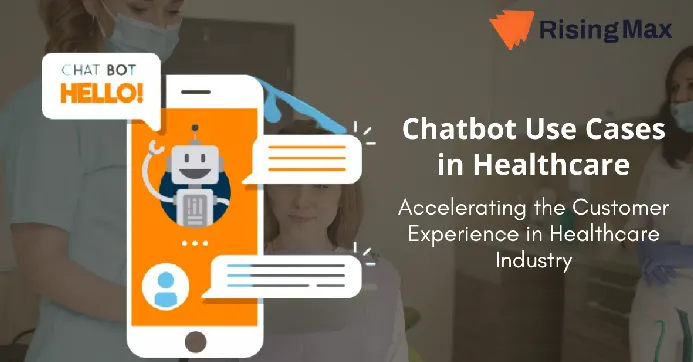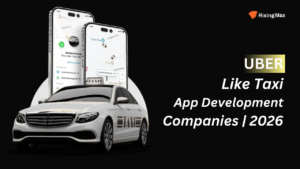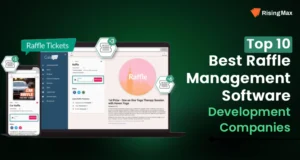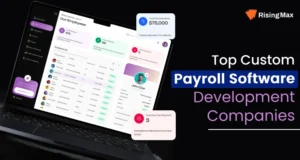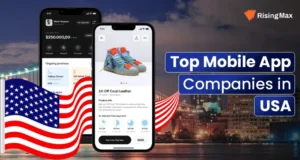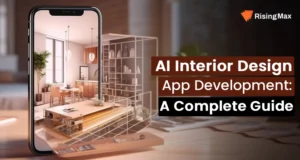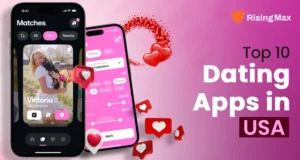The Chatbot is setting a new benchmark in the healthcare sector since its evolution. Whether it’s about managing customer service in a small healthcare company or the large one, AI-powered Chatbot helps meet business goals faster.
Even after being a leader in the industry, many healthcare businesses fail to deliver satisfactory performance. And that’s where tools like Chabot and Virtual assistants have shown a way to overcome all types of hurdles.
As per the recent report from Accenture, it is predicted that 40% of healthcare service providers have been continually using Chatbots to address the customers’ needs better. Various Chatbot use cases in the healthcare industry have proven beneficial in terms of improving customer responses.
What are AI Chatbot – Healthcare chatbot use cases
AI-powered Chatbots can be used to assist patients and guide them to receive the appropriate help. Chatbots are the most reliable alternative for patients looking to understand the cause of their symptoms. On the other hand, Chatbots help healthcare providers to reduce their caseloads. That is why healthcare chatbot use cases increase day by day.
Chatbots help better analyze the patient data and allow virtual discussion instead of physically visiting the clinic. All that means that the burden of medical professionals can be lowered by integrating Chatbot technology inside healthcare with the best AI Chatbot development company.
Furthermore, AI Chatbots can help providers diagnose diseases more consistently and accurately. As a result, healthcare professionals will be able to serve a more significant number of patients. Immediate assistance in emergency circumstances and providing answers for simple medical difficulties are the most common advantages of deploying bots.
The Mechanism Behind Chatbot & Healthcare Chatbot Use Cases
It’s true that Chatbot use cases in healthcare can help with specific problems. Patients are encouraged by the tailor-made Chatbot, which addresses their misunderstandings regarding the surgery and provides information responsively and conversationally. By communicating with users in a human-like manner, a medical Chatbot aids the job of a healthcare provider and helps them enhance their performance.
Intelligent medical Chatbots could aid physicians, nurses, therapists, patients, and their families in various ways. They can step in and cut down on the time they spend on things like:
- Deliver health-related information to users
- Quick guidance for patients
- Proper medication management and dosage
- Resolving FAQ-type queries like contact details, directions, opening hours, and service/treatment details
Healthcare Chatbot Use Cases Explains How AI Chatbot Metamorphosing Healthcare?
All healthcare providers are eager to assist their patients, but their burden prevents them from providing the best service possible. A Chatbot and its use cases in healthcare can help healthcare businesses to ensure 24/7 availability, answer repetitious inquiries, and arrange appointments on the go.
Immediate access to care – A Chatbot connects you with the appropriate specialist and notifies care teams about the patient emergencies.
Health monitoring – Patients require more than just immediate medical assistance. They need health monitoring and more information. As a result, a bot can assist with continued post-discharge care virtually.
Simple to use: For doctors and patients, Chatbots are simple to use. They come with much easy to use functionality.
Scalability: Using technology, healthcare organizations may provide customer support without having to hire extra people.
Improved patient satisfaction: These applications use robotic assistance to help overcome staff shortages. There will be no problem that goes unsolved.

Let See Chatbot Use Cases in Healthcare
For Checking Symptoms
The symptoms can be easily checked with Chatbots. Many healthcare providers use healthcare Chatbot use cases so that patients can check their symptoms to figure out what’s wrong with them. Because Chatbots use natural language processing (NLP), they can readily grasp the user’s request regardless of the input. Patients save time and money with Chatbots, while doctors can devote more attention to patients, making it a win-win situation for both.
Chatbots assist patients in narrowing down the reason for their symptoms by analyzing data and applying knowledge of the input. The patient can determine whether over-the-counter drugs are sufficient or whether expert treatment is required. This is a popular chatbot use case in the healthcare industry.
For Scheduling Appointments
Gone are the days when many of us had to wait a long time on the phone to schedule a doctor’s appointment. This case study in the healthcare industry tells that booking appointments with doctors via text or messaging, with no human interaction is the great revolution in the healthcare industry. By streamlining the business process, healthcare Chatbot use cases can also provide users with a personalized experience when booking appointments. Patients can also receive appointment reminders via Chatbots.
For Answering FAQs
The most common aspect of the website is the frequently asked questions section. Many healthcare service providers are transforming FAQs by incorporating an interactive Chatbot feature to respond to users’ general questions. This is being implemented in hospitals and clinics so that people may find the information they need.
A Chatbot, for example, can respond to questions such as what are the business hours, what are the required paperwork for obtaining treatments, how much of the cost will be covered by insurance, what are the payment tariff rates, and so on. Patients will no longer need to call the clinic for minor issues. As a result, Chatbots serve as an all-in-one solution for answering all of a patient’s general questions in a matter of seconds.
For Tracking Health
Patients who require medical care regularly would benefit significantly from Chatbot use cases in healthcare. Patients and their doctors might be linked through healthcare service providers. As a result, the Chatbot may now give information and a record of the patient’s health condition and assist in the administration of the prescribed management medicine.
For Billing & Registration
We have one more case study in the healthcare industry that explains ai chatbot helping in the billing and registration department as well. With the integration of backend systems for producing bills, a Chatbot can handle registration, inventory, payment, and insurance claims administration. Service providers can use a Chatbot to answer queries about insurance claims, processes, and coverage.
For Collecting Patient Data
Simple questions concerning the patient’s name, residence, symptoms, current doctor, and insurance information can be used to extract information from Chatbots. Chatbots then save this data in the medical facility’s system, making patient admission, symptom tracking, doctor-patient contact, and medical record-keeping easier. By this case study in the healthcare industry explains
For Handling Insurance Inquiries
Patients and plan members can use Chatbots to get insurance services and healthcare resources. Furthermore, combining RPA or other automation systems with Chatbots, insurance claim processing, and healthcare billing can be automated.
For Providing Mental Health Support
Chatbot healthcare use cases provide mental health help and are mainly to provide cognitive-behavioral therapy (CBT) for patients with depression, PTSD, and anxiety or teach autistic individuals how to improve their social skills and job interview skills. Chatbots can be interacted with via text, audio, and cameras.
For Prescription Refills
Patients’ names, contact information, current doctor, last visit to the clinic, and prescription information are all collected by Chatbots. The Chatbot sends a request to the patient’s doctor for a final decision and notifies them when a refill becomes available. This enables doctors to execute prescription refills in batches or automate them when a doctor’s intervention is not required.
For Hiring & Training
Large healthcare organizations are always on the lookout for new staff to hire onboard. They frequently generate a lot of documentation that needs to be filled out and credentials that need to be double-checked to process these applications. The task of Human Resources departments will be made more accessible by connecting Chatbots to such facilities.
Chatbots may be used to email files to recruits as needed, automatically remind new hires to complete their forms, and automate various other duties such as vacation requests, maternity leave requests, and more.
What is the Best Way to Build a Medical Chatbot?
For someone with no prior experience in the technical field, developing a healthcare Chatbot might be a tremendous challenge. All of the innovations began with a concept. The development of Chatbots follows a similar pattern. Have an idea, sketch a plan, and then go for the final design.
After that, make your plan with necessities in mind. You can then move on to prototyping and testing your software. To create an engaging medical Chatbot, follow these steps.
1. Set the purpose
The initial step in the development process is research and analysis. The idea behind the bot implementation must be crystal clear. This step clarifies the issues that the bot will address. You must have a conversational pathway in place in which you have to create all relevant questions and replies that Chatbot has to answer.
On the other hand, the design of the Chatbot completely depends upon the purpose; whether the need is for informative or conversational Chatbot. All that means, you need to set a purpose and then design it accordingly.
2. Check user’s personality
It’s critical to consider your users’ personalities because they will influence the character of your bot. The true essence is defined by how your users perceive it when they interact with it. A Chatbot can be formal, professional, or simply robotic, depending on your preferences.
3. Make a Strategy
The next step is to create a powerful strategy. One can benefit from some immediate assistance in this regard. All you have to do now is examine your target audience, discover their preferences, and sketch a plan. This step is built on the foundation of steps one and two. Focus your full attention on the Chatbot use cases in healthcare and commercial objectives, and the barrier will be overcome.
4. Developing a prototype
This indicates that the moment has come to put the well-thought-out plans into action. Have an experienced Chatbot development team so that they begin to code and create the most suitable prototype.
5. Select the ideal user interface
The discussion between the human and the Chatbot will run smoothly if the user interface is good. And the UI is chosen based on the type of Chatbot. As a result, ensure that the developers select the appropriate user interface to enhance the entire experience and conversation.
6. A blend of artificial intelligence & human intelligence
When a medical Chatbot is unable to diagnose the symptoms entered by a patient, it is preferable to transfer the conversation to a healthcare expert. So, rather than merely creating an AI powered Chatbot, it’s best to integrate Human Intelligence and Artificial Intelligence to improve the results.
7. Create a chatbot that interacts in a natural way
A healthcare Chatbot must be created to provide a genuine interaction in order to be useful. You can employ natural language processing and certain comprehension tools to provide the correct context, which will improve the Chatbot’s overall response capacity. After you’ve finished designing the general Chatbot, you’ll need to train and test it before releasing it.
How Much Does Healthcare Chatbot Costs?
Developing a Chatbot from scratch cost somewhere around $30k to $50k. Also, it depends upon the technology partner you are choosing. The final cost will be determined on the basis of how advanced the Chatbot application you need.
To keep the development cost of Chatbot in the budget, it is recommended to utilize ready-made SDKs and APIs. Not only this approach lowers the development cost but also speed-en up the time of market launch. Below are the most common factors to consider help in determining the cost of Chatbot:
- Level of complexity
- Type of Industry
- Level of Interaction
Are You Ready to Build Your Healthcare Chatbot?
For healthcare service companies, Chatbots give up a world of possibilities. The healthcare Chatbot use case presented here demonstrates how Chatbots in the healthcare business automate patient interaction. You can also design a Chatbot for your hospital with the help of a Chatbot development company to provide unparalleled ease to your patients.
Now that you’re well aware of the process of designing and developing a successful Chatbot, it’s no more challenging to handle this task for you. RisingMax is an ideal choice if you are looking for a healthcare software development company that holds the right domain expertise and knowledge to develop a Chatbot that matches your organizational goal.
Feel free to contact IT consulting firms in New York if you need more in-depth research on what is already available in the software market or if you don’t know how to add artificial intelligence capabilities to your healthcare Chatbot.

